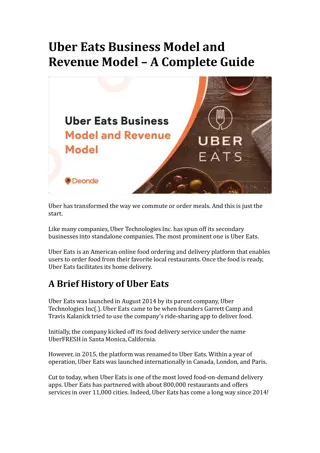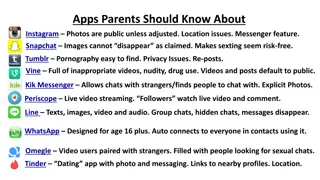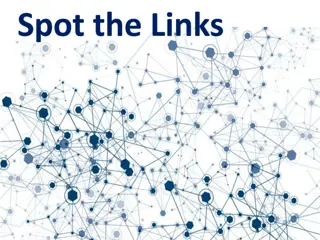
Snapchat Business Model Analysis and Risks Faced
Explore the business model of Snapchat, a popular social networking app, through SWOT analysis, target market evaluation, and risks faced in the competitive market. Discover the strengths, weaknesses, opportunities, and threats encountered by Snapchat in the dynamic world of social media. Gain insights into the challenges and potential growth avenues for this innovative platform that targets a youthful audience below 35 years of age.
Download Presentation

Please find below an Image/Link to download the presentation.
The content on the website is provided AS IS for your information and personal use only. It may not be sold, licensed, or shared on other websites without obtaining consent from the author. If you encounter any issues during the download, it is possible that the publisher has removed the file from their server.
You are allowed to download the files provided on this website for personal or commercial use, subject to the condition that they are used lawfully. All files are the property of their respective owners.
The content on the website is provided AS IS for your information and personal use only. It may not be sold, licensed, or shared on other websites without obtaining consent from the author.
E N D
Presentation Transcript
Libyan International University Faculty of Business Administration Snapchat Business Model By: Jassem Mohammed 1801 Email: jasem_1801@limu.edu.ly Instructor: Mr. Mohammed Alzwawi
Table of contents Snapchat SWOT Analysis Target market of snapchat 1 3 5 The Risks that the snapchat faces Analysis the Business Model of snapchat 2 4 Introduction
01 Introduction Snapchat is a photo, video, and chat-based social networking app that allows users to engage with one another. The main principle of the app is snapping. Every picture, video, or message you send is only visible to the recipient for a short period of time before disappearing. The brief existence was designed to encourage immediate and engaging contact. Both iOS and Android smartphones are supported by this App.
Target market of snapchat Snapchat isn't right for every business. Snapchat is primarily utilized by people under the age of 35 and is recognized for being a playful platform. However, if it sounds like a good fit for your company, make sure you have a solid social media plan in place before you start.
The Risks that snapchat faces The failure to retain users, the fact that the majority of its users are between the ages of 18 and 34 means it relies on a set of people who aren't recognized for their loyalty. On other hand the corporation admitted that the majority of its processing, storage, bandwidth, and other services are provided by Google Cloud. Any disruption in such service or a price increase would be disastrous for the company. Moreover, Apple, Facebook, and Google, for example, could use their strong or dominant positions in one or more markets to gain a competitive advantage over Snapchat. Collaboration to integrate their products, impeding Snapchat's accessibility, or simply consolidating.
Weaknesses Strengths The company's user base now stands at 166 million, with a 36 percent yearly growth rate. In the following three years, this number is likely to double. Many users began to compare Snapchat's offerings to those of other instant messaging apps. In terms of features, WhatsApp, for example, has more to offer. This is why this application did not make it to the top of the list of chat services. The app allows deleting communications within a specified time frame, which sets it apart from other messaging apps. For its intended demographic, this is a competitive advantage. Many people like this feature. Threats Opportunities Twitter, Facebook, WhatsApp, and Instagram are among the new and experienced competitors that Snapchat is up against. Working remotely is encouraged in the modern era of information technology firms. Their reliance on instant messaging platforms for communication is high in demand. In a time when concerns such as data theft are on the rise, as a result, in instant messaging services, privacy has become a must. This software has a number of features that provide enhanced security protection. Customers' pleasure with instant messaging is dependent on the speed of the network in their area, which can cause service problems in some areas
Business Model of snapchat
Analysis the Business Model
1. Snapchat Customer Segments: The Snapchat business model, like any multisided platform, includes multiple consumer segments. There are two in this case: Users: 218 million active users, about 70% of whom are between the ages of 13 and 17, with the fastest-growing markets being the United States, India, Brazil, and France. For advertising purposes, this audience will be micro- segmented. Advertisers: Companies that place ads on the Snapchat app. They're separated by size, intended audience, area, type, and more. 2. Snapchat Value Propositions: For each consumer segment, there are different value propositions: Users: Snapchat is a quick way to communicate that allows users to express themselves through photos and videos (with the help of its filters/editions), as well as life at the moment, without worrying about their appearance or anything else, because the posts will be deleted soon. While having fun, they can also learn about other individuals from around the world. Advertisers: Among 13-24-year-olds, Snapchat is arguably one of the most widely used platforms. Users will interact with commercials and companies without seeing them and will feel less "invaded" by them if they are reached using creative techniques. Businesses can also use Snapchat's self-serving capabilities to build their own adverts. In addition, e-commerce tools and APIs for integration are available.
3. Snapchat Channels: The app/website is the primary distribution mechanism for the Snapchat business strategy. However, there are alternative options: App stores are places where you can get apps. Use of social media Word-of-mouth marketing Snap partners and publishers. 4. Snapchat Customer Relationships: Customer relationships must be divided into customer categories: Users: Snapchat must demonstrate to its users that the site prioritizes their interests over advertising by providing a pleasant user experience; Advertisers: In addition to analytics (which businesses use to determine value), advertisers value self-serving ad development, partner and direct assistance models (for those who prefer to have a team put up advertising), and the ability to communicate directly with people. 5. Snapchat Revenue Streams: Snapchat earns money from advertising by providing marketers with ad spaces on its app. In fact, advertising provided 99 percent of Snapchat's entire income in 2020, according to the company. AR Ads and Snap Ads are used to do this.
6. Snapchat Key Resources: The app/platform and its network effects are the most important essential resources of a social network. Other critical assets for this to continue to work include content, consumers, relationships with advertising, employees, brand, technology infrastructure, and intellectual property. 7. Snapchat Key Activities: The core operations of the Snapchat business model revolve upon user engagement. As a result, the platform focuses on expanding its user base (including all important partners), innovating and improving the user experience, growing content, maintaining and developing the app and website, refining algorithms, and marketing. 8. Snapchat Key Partners: Users: Users contribute the majority of the material (which generates engagement). Influencers, media outlets, publications, websites, and a slew of others who create material specifically for this platform are known as content creators. Advertisers: Companies that pay for advertising and sponsorship to support the Snapchat business model. Ad technology and agency partners: Partners who use Snap APIs to create ads, target audiences, and track their progress. Third-party apps that interface with Snapchat is called developers.
9. Snapchat Cost Structure: The cost structure of Snapchat's business strategy hinges around any multisided platform expense: App/website and algorithm research and development. Upkeep of technology infrastructure. Staffing costs for sales and marketing, as well as general and administrative costs.
Conclusion The business's founders' refusal of a $3 billion acquisition by Mark Zuckerberg's Facebook Inc. in 2013 proved to be a well-played move, as Snap Inc., the parent company of Snapchat, is now worth over $37 billion. Despite the fact that the Snapchat app is responsible for the majority of its worth, Snap Inc. has grown significantly in the technology sector with the debut of the Spectacles device and the acquisitions of Bitmoji and Zenly.
References Snapchat business model and SWOT analysis - how does Snapchat Make Money? WikiSME. (2021, November 17). Pereira, D. (2022, May 20). Snapchat Business Model. Business Model Analyst. Haslett, E. (2017, February 3). 11 risks that keep Snapchat bosses awake at night. CityAM. .





















